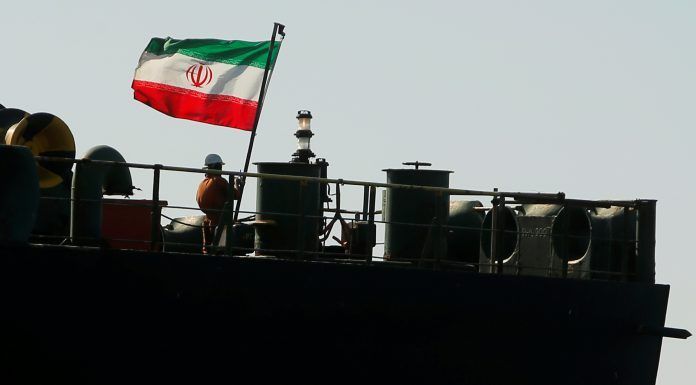The Iranian supertanker Adrian Darya 1 (formerly Grace 1) changed its course and headed for Turkey after Greece refused to allow the ship to refuel at its port of Kalamata.
British authorities detained Grace 1 off the coast of Gibraltar on July 4 on suspicion of carrying oil to Syria in violation of the EU sanctions. The ship was reportedly carrying 2.1 million barrels of Iranian crude oil worth nearly $130 million.
In what many believed to be a retaliatory response, Iran seized the British-flagged oil tanker Stena Impero in the Strait of Hormoz on July 19. Tehran has not released the tanker yet.
Meanwhile, British authorities released Adrian Darya 1 last week, despite pressures by the U.S. to keep it impounded in Gibraltar. The U.S. is, however, tracking the ship and has threatened to sanction any party that takes delivery of the oil.
“Adrian Darya 1 does not need an escort,” the Iranian Labor News Agency reported, citing Commodore Alireza Tangsiri, the commander of the Islamic Revolutionary Guards Corps Navy (NEDSA). “Iran’s Ports and Maritime Organization will have to decide whether to demand financial damages for the illegal seizure of the tanker or not.”
In its report, ILNA initially said that the Islamic Revolutionary Guards Corps (IRGC) had leased the oil tanker. The agency, however, issued a correction later the same day which read: “In the interview with the NEDSA commander, the reporter incorrectly said that the IRGC had leased Grace 1. That was not the case. After its release, the tanker changed its name to Adrian Darya 1. Russia owns the South Korean-made ship. An Iranian oil shipping company has leased it from Russia.”
It is unclear why Iran changed the tanker’s name from Grace 1 to Adrian Darya 1.
“Some people have misinterpreted changing the name of the tanker in Gibraltar as an attempt to bypass the sanctions. It was, however, necessary to change the name after Panama objected to the ship flying its flag. International maritime law requires that every merchant ship be registered in a country, its so-called flag state,” Iranian ambassador to the UK Hamid Baeidinejad tweeted on August 17. “We had to register the ship in Iran and fly our flag. It also meant that its name had to change. We must point out that the tanker is not under any sanctions. The ship’s cargo documents show that it carries crude oil belonging to the Iranian Oil Ministry.”
According to the ship-tracking website MarineTraffic.com, the tanker has updated its listed destination to the port of Mersin in southern Turkey. The site estimated that the tanker would arrive in Mersin on August 31.
While Iran has hailed the release of the Adrian Darya 1 by the Gibraltar authorities as a victory, it does not know how far the U.S. will go to prevent the tanker from reaching its destination. The ruling by a Gibraltar court to release the tanker ended the UK government’s involvement in the matter. A federal court in Washington, however, issued a warrant on July 17 for the seizure of the tanker.
Gibraltar authorities released the tanker only after Iran promised not to deliver the oil to Syria. It is, however, unclear where the ship will finally drop anchor. As of now, Greece has refused to allow Arian Darya 1 to refuel at its port of Kalamata. According to the latest information, the ship is heading for Turkey.
It is highly unlikely that the tanker could move through the Strait of Otranto and the North Sea-Mediterranean corridor to the Adriatic Sea, which would give it access to ports in eastern Italy and southeastern Europe including those in Croatia, Bosnia, and Montenegro.
The IRGC may deliver the oil directly to Russia by ordering the tanker to move towards northwestern Turkey and going through the Sea of Marmara, the Aegean Sea and Bosporus which is one of the principal waterways for transporting oil to the Black Sea. Every year 48,000 ships travel through the Bosporus. It is a major route between Russia and Kazakhstan.
Adrian Darya 1 may also make its way back to Iran through the Suez Canal. The U.S. and its allies patrol the Red Sea. Their naval ships can intercept and seize the Iranian tanker. Saudi Arabia will most likely join forces with the U.S. to thwart any operation by the IRGC. The Red Sea could be an arena for a showdown between Iran and the coalition forces.
Although some observers do not believe that the U.S. will take any direct action against the Adrian Darya 1, it could seize the tanker in the international waters or the Mediterranean Sea or the Red Sea.
[Translated from Persian by Fardine Hamidi]



